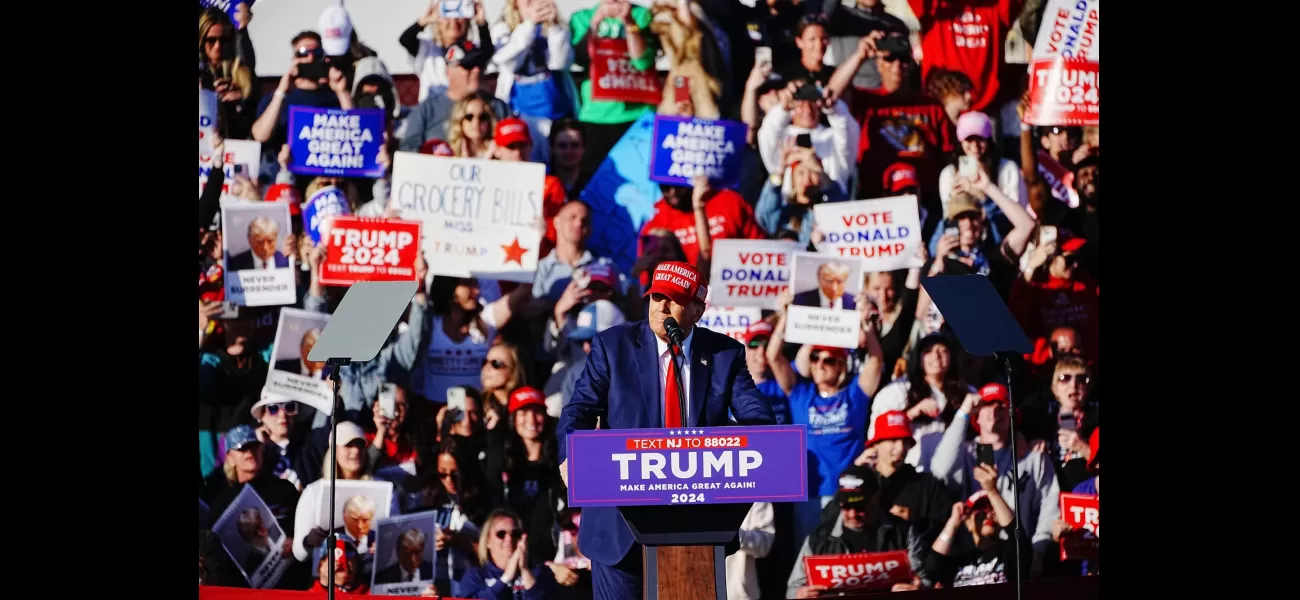Trump promises to decrease costs, but certain actions could result in increases.
Trump blames Biden for high grocery prices, but hasn't outlined a solution.
June 8th 2024.

Former President Donald Trump has been vocal about the rise in prices at the grocery store and other places where Americans shop, placing the blame on President Joe Biden and promising to "fix it." However, his plans to lower prices have been vague, and experts say that some of his policies could actually lead to an increase in prices.
One of Trump's signature policy plans is to carry out the largest domestic deportation in American history, which could potentially drive up the cost of labor. He also plans to impose tariffs on imported goods, which would likely result in higher prices for both imported and domestically made products. Additionally, he wants to make the 2017 tax cuts permanent and introduce new tax cuts, which could stimulate an economy that is already at full employment. However, experts warn that these policies could contribute to inflation and cause continued price increases.
According to Michael Strain, the director of economic policy studies at the American Enterprise Institute, Trump's trade and immigration policies are likely to result in price spikes. The post-pandemic inflation wave has subsided, but the lingering effects on the cost of living have impacted the public's perception of the economy and Biden's performance.
The pandemic led to a global surge in inflation, and many economists believe that the Biden administration's March 2021 stimulus package may have contributed to the problem. While it helped with economic recovery, the large amount of spending also added fuel to the domestic inflation issue.
In response to criticism, Trump's campaign policy director, Vince Haley, argues that Biden's policies will continue to drive up prices, while Trump's plans to increase energy production, cut regulations, and reduce federal spending will have the opposite effect. However, experts point out that while these actions may lower production costs for businesses, the global market for oil and gas would limit the impact on energy prices.
Trump has also promised to revive and expand his deregulatory efforts and roll back environmental rules imposed by the Biden administration. This could potentially reduce production costs for businesses, but it is unclear if Trump would be successful in this regard. Additionally, while cutting federal spending may help reduce demand for goods and services, Trump's previous term as president saw an increase in both spending and budget deficits.
The pandemic and its aftermath led to a surge in inflation as governments and central banks attempted to mitigate the economic impact. As vaccines became available, economic activity increased, leading to supply chain disruptions and shortages. This, combined with global events such as Russia's invasion of Ukraine and an outbreak of bird flu, led to a peak inflation rate of 9.1% in June 2022.
However, the Federal Reserve's actions and the resolution of supply chain issues helped bring the inflation rate down to a more normal level of 3.4% in April 2024. While prices for groceries and other goods have decreased, the public is still feeling the effects of the inflation surge, leading to dissatisfaction with the current state of the economy.
In conclusion, while the pandemic played a significant role in the rise in inflation, leaders also made choices that impacted the economy. Trump's policies, if implemented, could potentially lead to further price increases, and it remains to be seen how the Biden administration will address the issue.
Former President Donald Trump has been vocal about blaming President Joe Biden for increased prices in stores across America. He has promised to address this issue, but has not provided any clear explanation for how his plans would actually lower prices. In fact, according to a number of economists, some of Trump's policies could actually drive prices even higher.
For example, Trump has proposed the "largest domestic deportation in American history," which would likely result in higher labor costs. Additionally, his plans to impose tariffs on imported goods and make permanent the 2017 tax cuts could put further upward pressure on prices. These policies could also lead to continued inflation, adding to the already existing problem.
Michael Strain, the director of economic policy studies at the American Enterprise Institute, believes that Trump's trade and immigration policies would result in price spikes. And while inflation has subsided since the pandemic, the lasting effects on the cost of living have left many Americans dissatisfied with the state of the economy and Biden's performance.
The global surge in inflation was not unique to the United States, but many economists believe that the Biden administration's March 2021 stimulus package played a role in exacerbating the issue. While it did contribute to a faster recovery, it also added fuel to the inflation problem.
When questioned about this, Trump's policy director, Vince Haley, refuted the idea that Trump's second-term policies would further raise prices or reignite inflation. He argued that Trump's plans to increase energy production, cut regulations, and reduce federal spending would help keep prices down. However, there is no detailed economic plan from Trump to support these claims.
One of Trump's main arguments against inflation is his belief that expanding renewable energy to combat climate change, as the Biden administration is doing, will lead to higher energy prices. Trump instead proposes promoting fossil fuel extraction to make gasoline and electricity cheaper. However, experts believe that this would only have a small impact on global energy prices.
Haley also claims that Trump would roll back environmental regulations and work with a Republican Congress to reduce federal spending, which would help lower prices. However, during Trump's presidency, federal spending and budget deficits actually increased, and it is uncertain if he would be able to successfully revive impoundment, a tactic that was outlawed in 1974.
The surge in inflation during the pandemic was a result of increased economic activity and supply chain disruptions. As vaccines became available, people started spending money they had saved during lockdowns, and the job market rapidly recovered. This led to shortages of goods and a rise in prices globally.
In the United States, inflation peaked in June 2022 at 9.1%, the highest it had been since the early 1980s. However, the Federal Reserve intervened by raising interest rates and addressing supply chain issues, leading to a decrease in inflation. While prices are still higher than the ideal rate, they have begun to normalize.
Despite this, the lingering discontent and dissatisfaction with higher prices remains. While some factors contributing to inflation were outside of the control of policymakers, their choices also played a role. The issue of inflation is a complex one, and it is important for leaders to carefully consider their policies and their potential impact on prices.
One of Trump's signature policy plans is to carry out the largest domestic deportation in American history, which could potentially drive up the cost of labor. He also plans to impose tariffs on imported goods, which would likely result in higher prices for both imported and domestically made products. Additionally, he wants to make the 2017 tax cuts permanent and introduce new tax cuts, which could stimulate an economy that is already at full employment. However, experts warn that these policies could contribute to inflation and cause continued price increases.
According to Michael Strain, the director of economic policy studies at the American Enterprise Institute, Trump's trade and immigration policies are likely to result in price spikes. The post-pandemic inflation wave has subsided, but the lingering effects on the cost of living have impacted the public's perception of the economy and Biden's performance.
The pandemic led to a global surge in inflation, and many economists believe that the Biden administration's March 2021 stimulus package may have contributed to the problem. While it helped with economic recovery, the large amount of spending also added fuel to the domestic inflation issue.
In response to criticism, Trump's campaign policy director, Vince Haley, argues that Biden's policies will continue to drive up prices, while Trump's plans to increase energy production, cut regulations, and reduce federal spending will have the opposite effect. However, experts point out that while these actions may lower production costs for businesses, the global market for oil and gas would limit the impact on energy prices.
Trump has also promised to revive and expand his deregulatory efforts and roll back environmental rules imposed by the Biden administration. This could potentially reduce production costs for businesses, but it is unclear if Trump would be successful in this regard. Additionally, while cutting federal spending may help reduce demand for goods and services, Trump's previous term as president saw an increase in both spending and budget deficits.
The pandemic and its aftermath led to a surge in inflation as governments and central banks attempted to mitigate the economic impact. As vaccines became available, economic activity increased, leading to supply chain disruptions and shortages. This, combined with global events such as Russia's invasion of Ukraine and an outbreak of bird flu, led to a peak inflation rate of 9.1% in June 2022.
However, the Federal Reserve's actions and the resolution of supply chain issues helped bring the inflation rate down to a more normal level of 3.4% in April 2024. While prices for groceries and other goods have decreased, the public is still feeling the effects of the inflation surge, leading to dissatisfaction with the current state of the economy.
In conclusion, while the pandemic played a significant role in the rise in inflation, leaders also made choices that impacted the economy. Trump's policies, if implemented, could potentially lead to further price increases, and it remains to be seen how the Biden administration will address the issue.
Former President Donald Trump has been vocal about blaming President Joe Biden for increased prices in stores across America. He has promised to address this issue, but has not provided any clear explanation for how his plans would actually lower prices. In fact, according to a number of economists, some of Trump's policies could actually drive prices even higher.
For example, Trump has proposed the "largest domestic deportation in American history," which would likely result in higher labor costs. Additionally, his plans to impose tariffs on imported goods and make permanent the 2017 tax cuts could put further upward pressure on prices. These policies could also lead to continued inflation, adding to the already existing problem.
Michael Strain, the director of economic policy studies at the American Enterprise Institute, believes that Trump's trade and immigration policies would result in price spikes. And while inflation has subsided since the pandemic, the lasting effects on the cost of living have left many Americans dissatisfied with the state of the economy and Biden's performance.
The global surge in inflation was not unique to the United States, but many economists believe that the Biden administration's March 2021 stimulus package played a role in exacerbating the issue. While it did contribute to a faster recovery, it also added fuel to the inflation problem.
When questioned about this, Trump's policy director, Vince Haley, refuted the idea that Trump's second-term policies would further raise prices or reignite inflation. He argued that Trump's plans to increase energy production, cut regulations, and reduce federal spending would help keep prices down. However, there is no detailed economic plan from Trump to support these claims.
One of Trump's main arguments against inflation is his belief that expanding renewable energy to combat climate change, as the Biden administration is doing, will lead to higher energy prices. Trump instead proposes promoting fossil fuel extraction to make gasoline and electricity cheaper. However, experts believe that this would only have a small impact on global energy prices.
Haley also claims that Trump would roll back environmental regulations and work with a Republican Congress to reduce federal spending, which would help lower prices. However, during Trump's presidency, federal spending and budget deficits actually increased, and it is uncertain if he would be able to successfully revive impoundment, a tactic that was outlawed in 1974.
The surge in inflation during the pandemic was a result of increased economic activity and supply chain disruptions. As vaccines became available, people started spending money they had saved during lockdowns, and the job market rapidly recovered. This led to shortages of goods and a rise in prices globally.
In the United States, inflation peaked in June 2022 at 9.1%, the highest it had been since the early 1980s. However, the Federal Reserve intervened by raising interest rates and addressing supply chain issues, leading to a decrease in inflation. While prices are still higher than the ideal rate, they have begun to normalize.
Despite this, the lingering discontent and dissatisfaction with higher prices remains. While some factors contributing to inflation were outside of the control of policymakers, their choices also played a role. The issue of inflation is a complex one, and it is important for leaders to carefully consider their policies and their potential impact on prices.
[This article has been trending online recently and has been generated with AI. Your feed is customized.]
[Generative AI is experimental.]
0
0
Submit Comment





